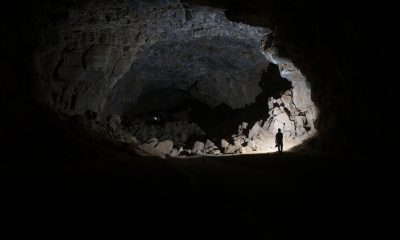Earliest evidence of mankind from 230,000 years ago found in Africa
Published
2 years ago onBy
Talker News
By Stephen Beech via SWNS
The oldest human remains in east Africa date back at least 30,000 years earlier than previously thought, making them the earliest evidence of man.
The ancient remains of a modern human have been redated to about 230,000 years ago.
The fossils – known as Omo I – were found in Ethiopia in 1967 by a team directed by leading anthropologist Richard Leakey, who died on January 2nd this year, aged 77.
Scientists have been attempting to date the oldest fossils in eastern Africa widely recognized as representing our species, Homo sapiens, precisely ever since.
Now an international team, led by Cambridge University scientists, has established that they are much older than previously thought by dating the chemical fingerprints of volcanic ash layers found above and below the sediments in which the fossils were found.
Earlier attempts to date the fossils suggested they were less than 200,000 years old, but the new research, published in the journal Nature, shows they must be older than a "colossal" volcanic eruption that took place 230,000 years ago.
The Omo I remains were found in the Omo Kibish Formation in southwestern Ethiopia, within the East African Rift valley. It is an area of high volcanic activity and a rich source of early human remains and artifacts including stone tools.
By dating the layers of volcanic ash above and below where archaeological and fossil materials are found, scientists identified Omo I as the earliest evidence of our species, Homo sapiens.
Study lead author Dr. Céline Vidal, of Cambridge University, said: “Using these methods, the generally accepted age of the Omo fossils is under 200,000 years, but there’s been a lot of uncertainty around this date.
“The fossils were found in a sequence, below a thick layer of volcanic ash that nobody had managed to date with radiometric techniques because the ash is too fine-grained.”
As part of a four-year project led by Professor Clive Oppenheimer, Dr. Vidal and her colleagues have been attempting to date all the major volcanic eruptions in the Ethiopian Rift around the time of the emergence of Homo sapiens, a period known as the late Middle Pleistocene.
The team collected pumice rock samples from the volcanic deposits and ground them down to sub-millimeter size.
Dr. Vidal said: “Each eruption has its own fingerprint - its own evolutionary story below the surface, which is determined by the pathway the magma followed.
“Once you’ve crushed the rock, you free the minerals within, and then you can date them, and identify the chemical signature of the volcanic glass that holds the minerals together.”
The researchers carried out new geochemical analysis to link the fingerprint of the thick volcanic ash layer from the Kamoya Hominin Site (KHS ash) with an eruption of Shala volcano, more than 250 miles away.
The team then dated pumice samples from the volcano to 230,000 years ago. Since the Omo I fossils were found deeper than that particular ash layer, they must be more than 230,000 years old.
Dr. Vidal said: “First I found there was a geochemical match, but we didn’t have the age of the Shala eruption.
“I immediately sent the samples of Shala volcano to our colleagues in Glasgow so they could measure the age of the rocks.
"When I received the results and found out that the oldest Homo sapiens from the region was older than previously assumed, I was really excited.”
Study co-author Professor Asfawossen Asrat, of Addis Ababa University in Ethiopia, said: “The Omo Kibish Formation is an extensive sedimentary deposit which has been barely accessed and investigated in the past.
“Our closer look into the stratigraphy of the Omo Kibish Formation, particularly the ash layers, allowed us to push the age of the oldest Homo sapiens in the region to at least 230,000 years.”
Co-author Dr Aurélien Mounier, of France's Musée de l’Homme, said: “Unlike other Middle Pleistocene fossils which are thought to belong to the early stages of the Homo sapiens lineage, Omo I possesses unequivocal modern human characteristics, such as a tall and globular cranial vault and a chin.
“The new date estimate, de facto, makes it the oldest unchallenged Homo sapiens in Africa.”
The researchers say that while the study shows a new minimum age for Homo sapiens in eastern Africa, it’s possible that new finds and new studies may extend the age of our species even further back in time.
Dr. Vidal said: “We can only date humanity based on the fossils that we have, so it’s impossible to say that this is the definitive age of our species.
“The study of human evolution is always in motion: boundaries and timelines change as our understanding improves.
"But these fossils show just how resilient humans are: that we survived, thrived and migrated in an area that was so prone to natural disasters.”
Prof Oppenheimer said: “It’s probably no coincidence that our earliest ancestors lived in such a geologically active rift valley - it collected rainfall in lakes, providing fresh water and attracting animals, and served as a natural migration corridor stretching thousands of kilometres.
“The volcanoes provided fantastic materials to make stone tools and from time to time we had to develop our cognitive skills when large eruptions transformed the landscape.”
Co-author Professor Christine Lane, of Cambridge University, said: “Our forensic approach provides a new minimum age for Homo sapiens in eastern Africa.
"But the challenge still remains to provide a cap, a maximum age, for their emergence, which is widely believed to have taken place in this region.
“It’s possible that new finds and new studies may extend the age of our species even further back in time.”
Dr. Vidal added: “There are many other ash layers we are trying to correlate with eruptions of the Ethiopian Rift and ash deposits from other sedimentary formations.
“In time, we hope to better constrain the age of other fossils in the region.”
Stories and infographics by ‘Talker Research’ are available to download & ready to use. Stories and videos by ‘Talker News’ are managed by SWNS. To license content for editorial or commercial use and to see the full scope of SWNS content, please email [email protected] or submit an inquiry via our contact form.
You may like


Study claims having this type of job can reduce risk of memory issues


Study claims AI better than doctors in accurately assessing eye problems


Remains of possibly largest marine reptile ever found on beach by girl


7 out of 10 teens on Twitter get bullied over their weight


Early humans used lava cave to shelter from elements 7,000 years ago


New method heals broken bones quicker and may make them stronger
Other Stories


Study claims having this type of job can reduce risk of memory issues
A research team measured the degree of cognitive stimulation while working.


Study claims AI better than doctors in accurately assessing eye problems
Are eye doctors going to get replaced by A-eye?


Remains of possibly largest marine reptile ever found on beach by girl
She made the "amazing" discovery while searching for fossils on a beach.


7 out of 10 teens on Twitter get bullied over their weight
Twitch was the second-highest social media platform linked to weight-related bullying.


Early humans used lava cave to shelter from elements 7,000 years ago
They used the shelter from the fierce desert sun.
Top Talkers

 Food & Drink1 week ago
Food & Drink1 week agoWe eat enough grilled cheeses a year to fill 900 Olympic swimming pools

 Broadcast1 week ago
Broadcast1 week agoOver 50% of Americans trust Google more than their schooling

 Animals1 week ago
Animals1 week agoAdorable Australian is a 4-year-old ‘wombat whisperer’

 Broadcast1 week ago
Broadcast1 week agoAmericans eat enough grilled cheeses a year to fill 900 Olympic swimming pools

 Broadcast7 days ago
Broadcast7 days agoGrocery shopping hungry is costing Americans this much
- Broadcast1 week ago
Why 3 in 4 prefer road trips over flying

 Funny7 days ago
Funny7 days agoCops confused by crow mimicking police siren

 Broadcast2 days ago
Broadcast2 days agoOver 40% of Americans have no clue what a 401k is
